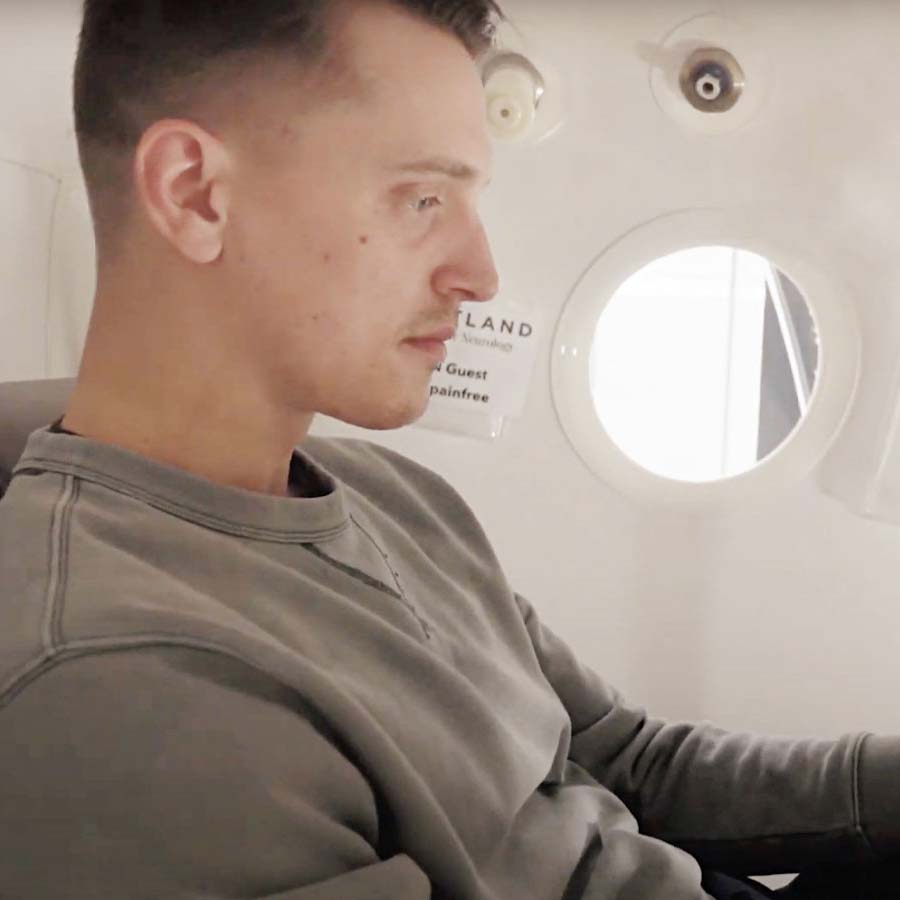
Treating Neurological Trauma with Hyperbaric Oxygen Therapy
Hyperbaric oxygen therapy enhances overall healing and function of the brain.
Hyperbaric oxygen therapy’s primary impact on our health is through its remarkable ability to increase plasma levels of oxygen though pressure that is necessary for all cellular function, healing, and signaling within our brain. As seen with many neurological conditions or brain trauma such as concussions, getting adequate oxygen to our brain may be compromised as many individuals suffer from changes in neurological control of vasculature, heart rate, and blood pressure (dysautonomia), neuro-inflammation, and swelling after injury that reduces cerebral blood flow. For some, the effects continue and worsen over time as seen in post-concussion syndrome due to brain tissue injury and swelling further weakening neurological pathway function, slowing communication to other parts of the brain, resulting in a spreading area of dysfunction that expands like the rings in a pond after a rock is thrown into it, weakening signaling along its pathway.
Common conditions
Trauma can worsen a wide range of condition, including:
- Concussion
- Post-concussion syndrome
- Traumatic Brain Injury
- Stroke
- Dysautonomia (POTS, Orthostatic Hypotension, Orthostatic Intolerance)
- Migraine
- Headache (cluster, tension, occipital neuralgia, other)
- Lyme
- Multiple Sclerosis
- Dizziness
- Vertigo
- Neuropathy
- Post-Covid 19 (Long-haulers)
- Alzheimers/dementia
- Complex regional pain syndrome
How can hyperbaric oxygen therapy help reduce the effects of trauma by healing your brain tissue?
Hyperbaric oxygen therapy may be helpful due to its ability to improve brain tissue function by:
- providing abundant levels of plasma-rich oxygen to our brain tissue for healing
- reducing neuro-inflammation throughout our brain and body
- stimulating release of growth factors such as trophic factor to enhance neuroplasticity for the repair and regeneration of brain cells and their connections (synapses)
- stimulating growth of new blood vessels to supply the brain with greater circulation and oxygen to promote brain repair and regeneration by releasing greater amounts of vascular endothelial growth factor
- balancing our fight or flight and relaxation and digestion systems by strengthening the health of our autonomic nervous system, which impacts blood flow within our brain that may lead to cardiovascular changes, dizziness, headaches, slow processing, memory changes, temperature changes, easily stressed or overwhelmed, and many other symptoms
- increasing stem cell production for healing
- improving detoxification
- enhancing cerebrospinal fluid flow
Other benefits of hyperbaric oxygen therapy
Hyperbaric Oxygen Therapy is a quickly evolving science and the full benefits are continually being discovered. HBOT increases the amount of oxygen in our bloodstream and increases circulation to deliver abundant amounts of oxygen to the brain, supersaturating our tissue with energy needed for healing, growth, and repair. This creates a healthier environment for our brain to work and control our autonomic nervous system. Because of this, the benefits of hyperbaric oxygen therapy can be found in all parts of the body and in a wide range of ways. Some benefits can include:
- Faster healing from trauma
- Reduced inflammation
- Increased stem cell release
- Improved brain health
- Detoxification
- Improved autonomic nervous system function
- …and many more
Learn more about the many benefits of HBOT and how it works.
Supporting Research
- Clinically, HBOT induced significant improvement in the memory, executive function, information processing speed and global cognitive scores (Hadanny et al).
- The mechanisms by which HBOT induces brain neuroplasticity can be demonstrated by highly sensitive MRI techniques of DSC and DTI. HBOT can induce cerebral angiogenesis and improve both white and gray microstructures indicating regeneration of nerve fibers. The micro structural changes correlate with the neurocognitive improvements (Hadanny et al.).
- HBOT can induce neuroplasticity leading to repair of chronically impaired brain functions and improved quality of life in mTBI patients with prolonged PCS at late chronic stage (Gross et al.).
- The results indicate that HBOT can lead to significant neurological improvements
- Phase II study of two composite doses of hyperbaric therapy that demonstrated significant improvements in PCS and PTSD symptoms at the 2.4 atmospheres absolute (ATA) pure oxygen dose as well as the low-pressure 1.3 ATA air/oxygen dose (Hartch).
- To demonstrate that B-level evidence exists for the use of hyperbaric oxygen therapy (HBOT) as an effective treatment in mild to moderate traumatic brain injury/persistent postconcussion syndrome (mTBI/PPCS).
- Hyperbaric oxygen and hyperbaric air have demonstrated therapeutic effects on mTBI/PPCS symptoms and can alleviate posttraumatic stress disorder symptoms secondary to a brain injury in 5 out of 5 peer-reviewed clinical trials (Figueroa et al.).
- The current use of pressurized air (1.2-1.3 ATA) as a placebo or sham in clinical trials biases the results due to biological activity that favors healing (Figueroa et al.).
- In a review of available treatments for acquired brain injury (ABI), including TBI, HBOT was suggested with strong levels of evidence among non-pharmacological interventions of ABI. Furthermore, HBOT positively improved mortality with level 1 evidence (Meyer et al).
- HBOT remains one of the safest therapies used today (Heyboer et al.)
Sources
- Tal S, Hadanny A, Sasson E, Suzin G, Efrati S. Hyperbaric Oxygen Therapy Can Induce Angiogenesis and Regeneration of Nerve Fibers in Traumatic Brain Injury Patients. Front Hum Neurosci. 2017 Oct 19;11:508. doi: 10.3389/fnhum.2017.00508. PMID: 29097988; PMCID: PMC5654341.
- Boussi-Gross R, Golan H, Fishlev G, Bechor Y, Volkov O, Bergan J, et al. Hyperbaric oxygen therapy can improve post concussion syndrome years after mild traumatic brain injury – randomized prospective trial. PLoS One. 2013; 8(11): e79995.
- Efrati S, Fishlev G, Bechor Y, Volkov O, Bergan J, Kliakhandler K, et al. Hyperbaric oxygen induces late neu- roplasticity in post stroke patients–randomized, prospective trial. PLoS One. 2013; 8(1): e53716.
- Harch PG. Hyperbaric oxygen therapy for post-concussion syndrome: contradictory conclusions from a study mischaracterized as sham-controlled. J Neurotrauma. 2013 Dec 1;30(23):1995-9. doi: 10.1089/neu.2012.2799. Epub 2013 Oct 11. PMID: 24004322; PMCID: PMC3837504.
- Kendall et al. Different oxygen treatment pressures alter inflammatory gene expression in human endothelial cells. March 2013. Undersea & hyperbaric medicine: journal of the Undersea and Hyperbaric Medical Society, Inc 40(2):115-23
- Huang L, Obenaus A. Hyperbaric oxygen therapy for traumatic brain injury. Med Gas Res. 2011 Sep 6;1(1):21. doi: 10.1186/2045-9912-1-21. PMID: 22146562; PMCID: PMC3231802.
- Figueroa XA, Wright JK. Hyperbaric oxygen: B-level evidence in mild traumatic brain injury clinical trials. Neurology. 2016 Sep 27;87(13):1400-6. doi: 10.1212/WNL.0000000000003146. Epub 2016 Aug 31. PMID: 27581219.
- Huang L, Obenaus A. Hyperbaric oxygen therapy for traumatic brain injury. Med Gas Res. 2011; 1(1): 21.
- Neubauer RA, James P. Cerebral oxygenation and the recoverable brain. Neurol Res. 1998; 20 Suppl 1: S33-6.
- Vlodavsky E, Palzur E, Soustiel JF. Hyperbaric oxygen therapy reduces neuroinflammation and expression of matrix metalloproteinase-9 in the rat model of traumatic brain injury. Neuropathol Appl Neurobiol. 2006; 32(1): 40-50.
- Lin KC, Niu KC, Tsai KJ, Kuo JR, Wang LC, Chio CC, et al. Attenuating inflammation but stimulating both angio- genesis and neurogenesis using hyperbaric oxygen in rats with traumatic brain injury. J Trauma Acute Care Surg. 2012; 72(3): 650-9.
- Hishikawa K, Nakaki T, Suzuki H, Saruta T, Kato R. New method of investigating functional roles of pressure-sensitive mechanoreceptor in human endothelial cells. J Cardiovasc Pharmacol. 1992;20 Suppl 12:S66-7. doi: 10.1097/00005344-199204002-00020. PMID: 1282990.
- Zhou Z, Daugherty WP, Sun D, Levasseur JE, Altememi N, Hamm RJ, Rockswold GL, Bullock MR. Protection of mitochondrial function and improvement in cognitive recovery in rats treated with hyperbaric oxygen following lateral fluid-percussion injury. J Neurosurg. 2007 Apr;106(4):687-94. doi:
Contact Us
Ready to discuss how hyperbaric oxygen therapy can help you heal, rebuild and restore health?
Contact Us